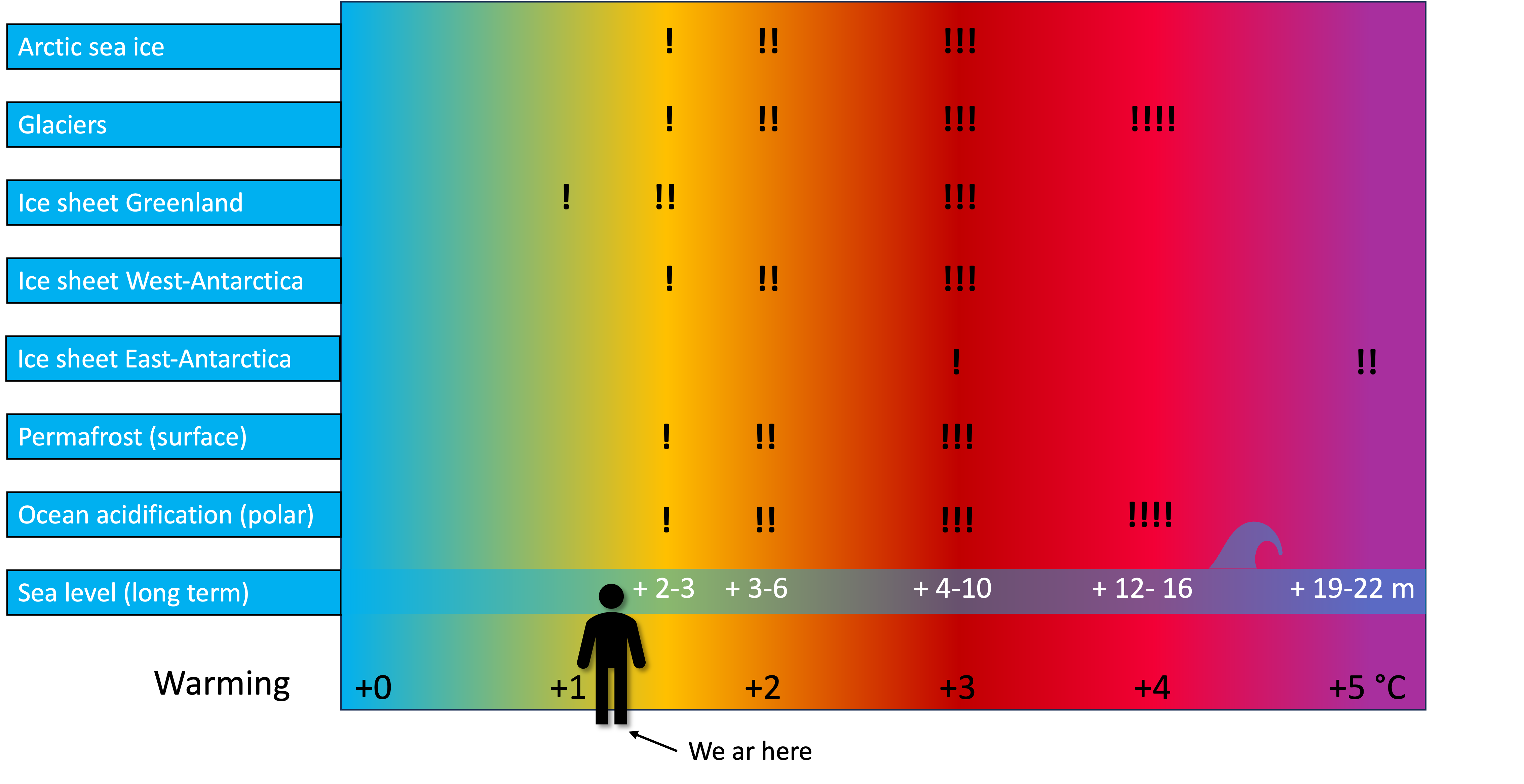Climate Special – Theory
by Hanna Knahl

Several elements in our climate system are on the edge, e.g. the ice sheet in Greenland… Picture: Pixabay
Global warming should not exceed 1.5°C, according to the Paris Climate Agreement. Fridays for future and other climate activist groups are fighting for this. Why 1.5°C, actually?
There are a number of possible so-called tipping points in the climate system. These tipping points are sensitive to temperature changes. But first things first…
| What are tipping points?
When a tipping point is crossed, the state of a system changes due to a change from the outside. Simple example:
Somewhere between the external circumstance “upright” and “lying down” is the tipping point. At this tipping point it is decided whether the glass tips over and deflates or not. An important property of a tipping point describes whether it is reversible or not. If it is not reversible, the system will not tip back as easily as it tipped in. Tipping the glass over is quite easy and happens all too quickly, as one keyboard or another has already painfully experienced. Once the glass is tipped out, it becomes very tedious to get all the water from the keyboard back into the glass (“event freely invented – in my case it was coke…”). Just putting the glass back in place is not enough. And besides, maybe even the keyboard has changed from the state “working” to “broken”. Shhhh**! |

Everyone has probably experienced this: a glass of water tips over from the edge of the table. Then bring the water back into the glass? Tricky… (Kipppunkt=tipping point, irreversibel=irreverible) Image: Own drawing
Tipping points in the climate system quite often depend on the external circumstance of temperature [1]. If the air or the ocean warms, this can cause various elements of the climate system to tip from their current state to another:
As for example in the Alps: glacier → no glacier.
Or in the Arctic: permafrost stable → permafrost thawing.
The ice sheet in West Antarctica also has such a tipping point. It is dependent on both air temperature and ocean temperature. This is because large parts of the ice sheet “float” on the ocean as so-called ice shelves. If the air and ocean become warmer, the ice sheet is melted from above as well as from below. This makes it particularly vulnerable. And its tipping point is irreversible. It takes much more time and a greater change in external circumstances to build up an ice sheet than to melt it.
Antarctica is far away, but it affects us greatly because the ice sheet stores a lot of water. If this water gets into the oceans, sea level changes all over the world. It does not change everywhere in the same way (exciting, but leads too far here), but on average it rises.
We are currently at +1.1°C global warming [1]. As a reminder, we actually do not want to exceed +1.5°C. A commentary published in the journal “nature climate change” in January 2023 by Uta Klönne and others [1] has collected different tipping points of the climate system and their current study situation. It presents at which global temperature increase, which tipping points could be reached. The tipping points are of course a bit more complex than with our glass and it is not only distinguished between “full” and “empty”, but in several gradations.
Results
The ice sheet is most sensitive at the other pole, in Greenland. Already now at +1.1°C the Greenland Ice Sheet is strongly threatened. All other listed tipping points are still rather calm. But from +1.5°C on, things really “take off”. Glaciers, sea ice in the Arctic, permafrost, acidification of the South Ocean and also the West Antarctic Ice Sheet will then have a problem.

The considered tipping elements and their danger in case of global warming. The more “!”, the greater the danger of exceeding the tipping point. Image source: Simplified own representation based on [1].
How can we still meet +1,5°C?
+1.5°C can be roughly met if we reduce emissions by 40% (31-59) by 2030 and by 88% (77-100) by 2050 [1].
That’s why the scientists* around Uta Klönne say only halving our emissions by 2030 can minimize the risk of reaching tipping points. To underline this message, they named their paper:
“Only halving emissions by 2030 can minimize risks of crossing cryosphere thresholds”
Something hopeful to conclude? The thawing of permafrost also has a tipping point. Thawing would produce huge amounts of greenhouse gases, which would then further warm the climate. Where does that leave the positive? A much-discussed runaway effect, in which the climate would simply keep warming due to thawing of the permafrost, would probably not occur [4]. One horror scenario less.
More information about tipping points
If you are interested in more tipping elements of the climate system, I recommend the info page of the Potsdam Institute for Climate Impact Research on this topic.
There is also the Greenpeace project @Grad.jetzt , which wants to make tipping points visible.

Meereisdaten von 01. bis 31. Juli 2023 stammen von www.meereisportal.de (Förderung: REKLIM-2013-04).
A lot of research and visualization is also being done on tipping elements in Bremen and Bremerhaven. A good example is the development of sea ice. You can follow the shrinking of sea ice in the Arctic on the sea ice portal of the Alfred Wegener Institute in Bremerhaven. There you can find out for yourself how much sea ice there currently is and how much it has already shrunk. You will also find the latest sea ice knowledge, which is being researched at the AWI and the Institute for Environmental Physics in Bremen.
Researchers are always discussing which elements of the climate system actually have tipping points and which ones might be reversible or gradually changing. Arctic sea ice is one example where scientists disagree on whether it is a tipping element or not. Either way, sea ice is an important part of the climate system and it is changing extremely rapidly. See for yourself at the Sea Ice Portal.
From theory to action
Politics and industry have a lot to do to limit global warming to 1.5°C. But also students of the University of Bremen can do something. You can find an example of this in our second Climate Special (in German). Have you heard of the “Krümelmonster” (Cookie Monster)? Amelie introduces you to a group that fights for climate and social justice at the university and has occupied the “Keksdose” (cookie jar).
Sources:
[1] Kloenne, U., Nauels, A., Pearson, P. et al. Only halving emissions by 2030 can minimize risks of crossing cryosphere thresholds. Nat. Clim. Chang. 13, 9–11 (2023). https://doi.org/10.1038/s41558-022-01566-4
[2] https://www.climate.gov/news-features/understanding-climate/climate-change-global-sea-level (24.08.23)
[3] Betzold, C. Adapting to climate change in small island developing states. Climatic Change 133, 481–489 (2015). https://doi.org/10.1007/s10584-015-1408-0
[4] Josep G. Canadell, Pedro M.S. Monteiro, Marcos H. Costa, Leticia Cotrim Da Cunha, Peter M.
Cox, et al.. Global Carbon and other Biogeochemical Cycles and Feedbacks. IPCC AR6 WGI, Final
Government Distribution, chapter 5, 2021. hal-03336145
[5] Spreen, G.; Kaleschke, L. and Heygster, G. (2008), Sea ice remote sensing using AMSR-E 89 GHz channels J. Geophys. Res.,vol. 113, C02S03, doi:10.1029/2005JC003384.








Leave a Reply